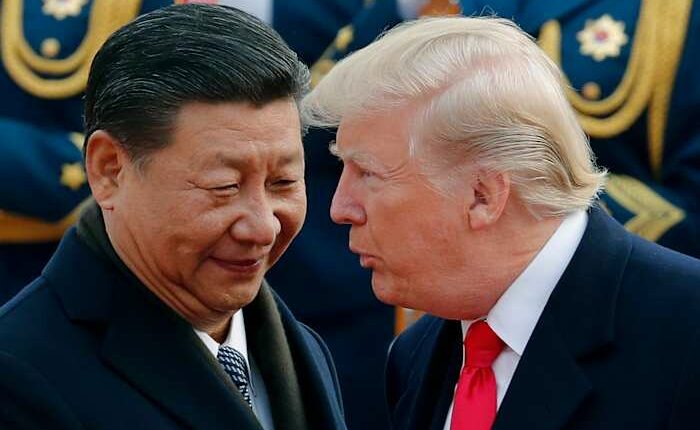Share this @internewscast.com

GYEONGJU – In a significant diplomatic encounter, President Donald Trump is poised to meet with Chinese President Xi Jinping on Thursday. This meeting represents a crucial opportunity for the leaders of the globe’s two largest economies to restore equilibrium in their relations following prolonged tensions over trade disputes.
Trump’s assertive imposition of tariffs, coupled with China’s counteraction through export restrictions on rare earth elements, has heightened the need for this dialogue. Both nations recognize the potential threat to the global economy if these conflicts remain unresolved, which could have adverse effects on their domestic economies.
In anticipation of the meeting, U.S. officials have indicated that Trump is unlikely to enforce his recent threat of a 100% import tax on Chinese goods. Meanwhile, China has shown willingness to ease its export controls on rare earth elements and is considering increasing its purchase of soybeans from the United States.
While aboard Air Force One en route to South Korea, Trump suggested he might reduce tariffs previously imposed on China due to its involvement in the production of fentanyl. “I expect to be lowering that because I believe that they’re going to help us with the fentanyl situation,” Trump remarked, further noting, “The relationship with China is very good.”
The anticipated discussions are scheduled to begin at 11 a.m. (8 p.m. ET) in Busan, South Korea. Busan, a bustling port city located approximately 76 kilometers (47 miles) south of Gyeongju, serves as the principal location for the Asia-Pacific Economic Cooperation summit.
The meeting is set to begin at 11 a.m. (8 p.m. ET) in Busan, South Korea, a port city about 76 kilometers (47 miles) south from Gyeongju, the main venue for the Asia-Pacific Economic Cooperation summit.
At a dinner on Wednesday night with other APEC leaders, Trump was caught on a microphone saying the meeting with Xi would be “three, four hours” and he would then go home to Washington.
Officials from both countries met earlier this week in Kuala Lumpur to lay the groundwork for their leaders. Afterward, China’s top trade negotiator Li Chenggang said they had reached a “preliminary consensus,” a statement affirmed by U.S. Treasury Secretary Scott Bessent who said there was “ a very successful framework.”
The anticipated detente has given investors and businesses caught between the two nations a sense of relief. The U.S. stock market has climbed on the hopes of a trade framework coming out of the meeting.
However cordial the rhetoric, Trump and Xi remain on a potential collision course as their countries vie to dominate manufacturing, develop emerging technologies such as artificial intelligence and shape world affairs such as the status of Russia’s war in Ukraine. Trump indicated that he did not plan to bring up issues such as the security of Taiwan with Xi.
“The proposed deal on the table fits the pattern we’ve seen all year: short-term stabilization dressed up as strategic progress,” said Craig Singleton, senior director of the China program at the Foundation for Defense of Democracies. “Both sides are managing volatility, calibrating just enough cooperation to avert crisis while the deeper rivalry endures.”
The U.S. and China have each shown they believe they have levers to pressure each other, and the past year has demonstrated that tentative steps forward can be short-lived.
For Trump, that pressure comes from tariffs.
Right now, China had faced new tariffs this year totaling 30%, of which 20% has been tied to its role in fentanyl production. But the tariff rates have been volatile. In April, he announced plans to jack the rate on Chinese goods to 145%, only to abandon those plans as markets recoiled.
Then, earlier this month, ahead of this meeting with Xi, Trump threatened a 100% import tax because of China’s rare earth restrictions.
Xi has his own chokehold on the world economy because China is the top producer and processor of the rare earth minerals needed to make fighter jets, robots, electric vehicles and other high-tech products.
China tightened export restrictions on Oct. 9 right before the Trump-Xi meeting, repeating a cycle in which each nation jockeys for an edge only to back down after more trade talks.
What might also matter is what happens directly after their talks. Trump plans to return to Washington, while Xi plans to stay on in South Korea to meet with regional leaders during the Asia-Pacific Economic Cooperation summit, which officially begins on Friday.
“Xi sees an opportunity to position China as a reliable partner and bolster bilateral and multilateral relations with countries frustrated by the U.S. administration’s tariff policy,” said Jay Truesdale, a former State Department official who is CEO of TD International, a risk and intelligence advisory firm.
___
Boak reported from Tokyo.
Copyright 2025 The Associated Press. All rights reserved. This material may not be published, broadcast, rewritten or redistributed without permission.












